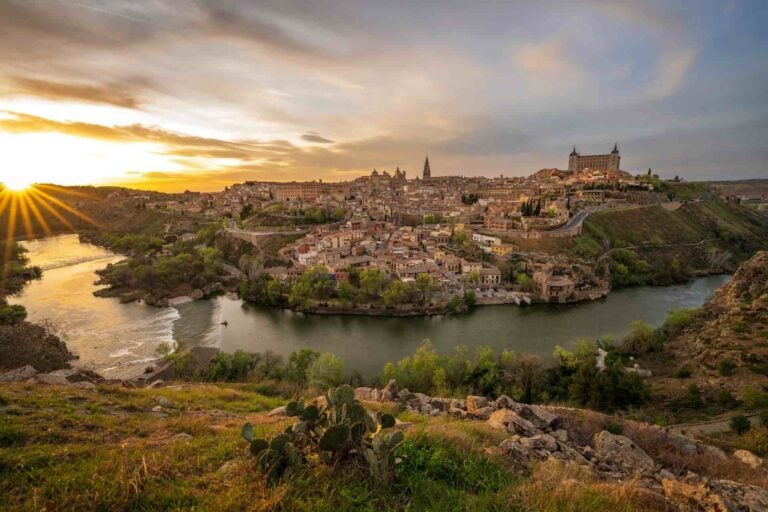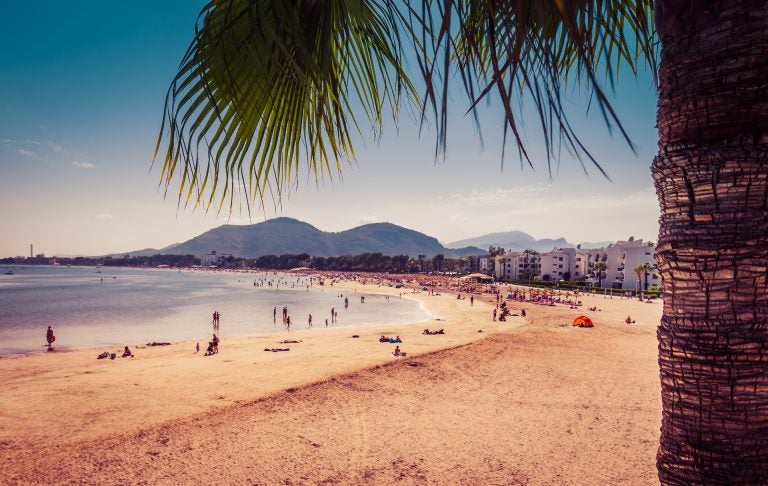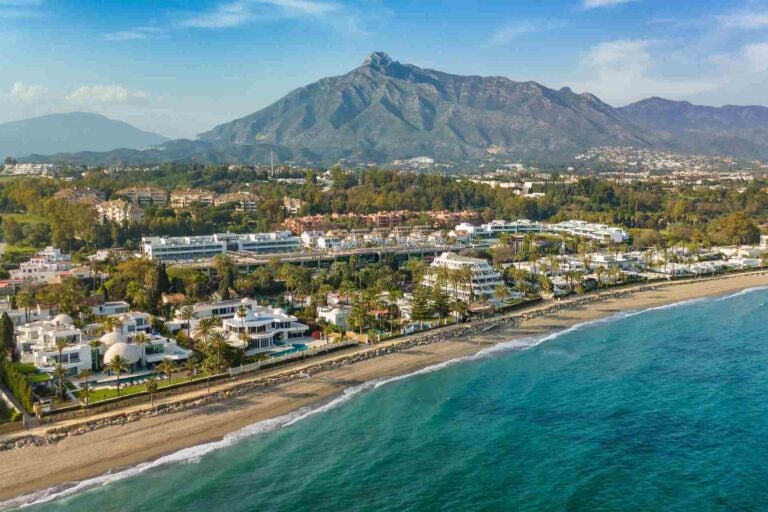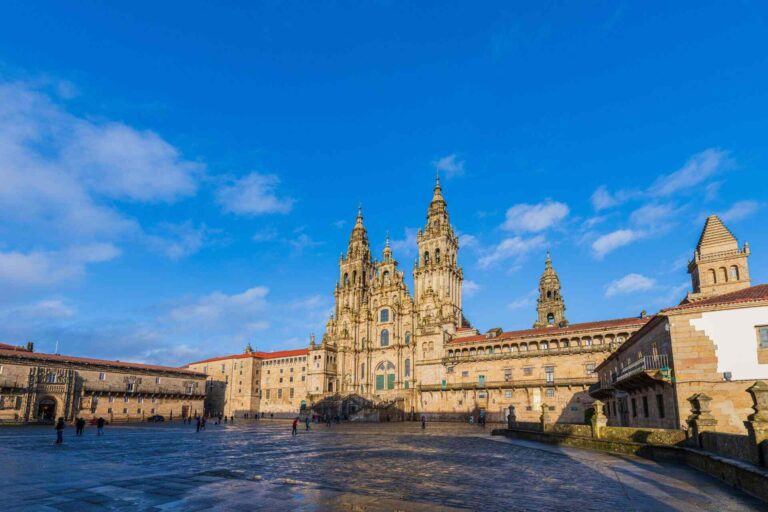Spain travel guide: All you need to know
Enjoy the wonders of Spain with this travel guide to learn about its culture, gastronomy, best beaches and tourist cities, and much more.
Fancy a trip to Spain? This impressive country has got you covered, as the destinations suit all tastes Visiting Spain soon? From mouthwatering foods and stunning landscapes to unique cultural experiences and breathtaking architecture, the country has plenty to offer.
That said, it’s easy to get lost in the possibilities, especially if you’re only visiting for a short trip. Don’t worry, though. We’ve made this extensive Spain travel guide to help you make the most of your experience here.
Visiting Spain: General information
Before you dive into planning your Spanish adventure, here are some essential facts you need to know:
- Climate: Spain’s weather can be everywhere, depending on where and when you visit. Temperatures can range from freezing in the winter to 40°C (104°F) in the summer.
- Language: Spanish is the official language, but there are some regional languages as well, like Catalan, Valencian, Galician, Basque, Asturian, or Aragonese.
- Currency: Euro.
- Time Zone: It’s Central European Time UTC+1, and Central European Summer Time UTC+2 during those sunny months.

You’ll be able to pay by card in most places, but it doesn’t hurt to have cash for tips at restaurants or some local markets that may not accept cards. So make sure to exchange some Euros before your trip or at an official exchange once you arrive. Avoid exchanges in touristy areas, though, as they often offer a worse rate.

Main things to consider
Before heading to this beautiful country, ensure you’ve got all the essentials covered. While it is tempting to just buy a ticket and jump on a plane, some things are better to care of in advance. You must be prepared for the essentials like documentation, staying connected, cultural norms, and staying safe. To explain, below you’ll find the lowdown on what to consider:
Travel documents
To get into Spain, you’ll need a passport with a minimum validity of six months. EU residents can enter the country with just their ID card. Travelers from some countries outside of the EU may require a visa to enter Spain, so make sure to double-check whether you need one or not before your trip.
So, to get that visa, check out the Spanish embassy or consulate in your home country.
There are 62 countries that don’t need a visa to enter Spain right now. But, starting in 2024, those countries will need to apply for an ETIAS permit, which is like an electronic pass that helps make the entry process smoother and quicker.
You’ll find the list of countries that need a visa to enter the European Union on the Schengen Visa web portal. The list below is accurate as of the writing of this article but may change, so do double-check the official website just in case.
| Countries that need a visa to enter Spain | ||
|---|---|---|
| Turkey | Iran | Vietnam |
| India | Irak | Tunisia |
| China | Jordan | Bolivia |
| Rusia | Lebanon | Armenia |
| Qatar | Morocco | Côte d’Ivoire |
| Algeria | Nigeria | Laos |
| Belize | North Korea | Philippines |
| Dominican Republic | Senegal | Mongolia |
| Ecuador | South Africa | Syria |
| Egypt | Thailand | Saudi Arabia |
While it’s not required by law, we strongly advise getting international travel insurance for your trip. It’s a safety net that’ll protect you from any unexpected trouble that might pop up during your trip.
If you plan to live and work as a digital nomad in Spain, you’ll also need to apply for a separate nomad Visa that allows you to extend your stay for up to a year.
Culture
Spanish culture is like a treasure trove filled with history, fantastic food, and incredible art. Make sure to sample the Spanish way of life. Try their savory dishes like paella, tortilla de patatas, Iberian ham, and tapas. Listen to the local music, visit the museums, and spend time at the local markets, getting to know the rhythm of life in the country.
Internet connection
Having steady internet access in Spain can make your time here much easier. Not only will you be able to share your memories on social media at any time, but you’ll also be able to find your way around more easily by using map apps or communicate with the locals using translator apps. And you simply can’t rely on free WiFi for those things.
Using an eSIM from Holafly is probably the best option. All Holafly plans include unlimited data, 24/7 customer support, and data sharing. The eSIM only takes a couple of minutes to set up, is easy to use, and will keep you connected throughout your stay in Spain.
If you don’t have an eSIM-compatible phone, you can resort to other options such as pocket WiFi, international roaming, or Spain SIM cards.
Best time to visit Spain
Weather-wise, the best times to visit Spain are spring (March to May) and autumn (September to November), when temperatures are pleasantly warm without being overwhelmingly hot or too cold. However, there’s hardly a bad time to visit, as there’s almost always something interesting going on here.
Winter can be a great time to visit if you’re on a tighter budget. Flights and accommodation tend to be cheaper at this time. The weather, especially in Southern Spain, can also be pleasantly warm, though it’ll still require a sweater.
If you want to experience Spain traditions firsthand, here are some of the main festivities you might want to attend:

- Carnivals (February): Spain’s festivals are world-renowned, with highlights in Cadiz, Las Palmas, Badajoz, and Santa Cruz de Tenerife.
- Las Fallas Valencianas (March 15-19): These festivities were declared International Tourist Interest and Intangible Heritage of Humanity. Key events include La Crida, La Plantà, La ofrenda, and the Nit de la Cremà.
- April Fair (April 14-20): One of Andalusia’s most popular festivals, you’ll find fair booths, flamenco shows, delightful gastronomy, dances, concerts, music, bull events, and fireworks.
- Fiestas de San Isidro (May 12-15): Witness dances, musical performances, fireworks, and the famous run with bulls through the city streets.
- Romería del Rocío (May 17-20): A grand pilgrimage attended by thousands yearly, where people sing, dance, and express gratitude to the Virgin of El Rocío.
- Festivities of San Fermin (July 6-14): One of Spain’s most important festivities, marked by bulls running in the streets of Pamplona.
- La Tomatina (August 30): During this unique event, participants have a one-hour tomato fight after picking tomatoes from designated trucks. This is followed by celebrations with local music and local food, most of which also contain tomatoes.
- Christmas (December 25-31): Tour the charming Christmas markets to savor and experience the local gastronomy during this festive season.

How to get to Spain?
Flying into Spain is the most popular form of travel unless you’re living in one of the neighboring countries. However, you can also drive here from any country in mainland Europe or combine your Spanish getaway with a cruise and arrive by sea.
Traveling to Spain by plane
The primary gateway for most international flights is Adolfo Suárez Airport (Madrid-Barajas) in Madrid or El Prat de Llobregat Aeropuerto in Barcelona. That said, there are plenty of smaller airplanes, allowing you to arrive closer to your target destination. Here are some of the best airlines to choose depending on where you’re arriving from:
- United States and Canada: For direct flights to Spain, consider American Airlines, Delta Airlines, United Airlines, Iberia, Air Canada, and Air Transat.
- Europe: There are many direct flights within Europe, making it convenient to reach Spain. Recommended airlines for this route include Iberia, Vueling, Air Europa, Ryanair, and EasyJet, which usually offer attractive seasonal prices.
- Latin America: Direct flights from Latin America to Spain usually take 9 to 12 hours, depending on the departure point. However, some flights have layovers that can extend the journey. For this journey, consider flying with Iberia, Air Europa, LATAM, Copa Airlines, or Avianca.
- Asia: The average duration of these flights is around 12 to 20 hours. While direct flights from Asia to Spain are less common, they are available. Look for flights with airlines like Iberia, Qatar Airways, Turkish Airlines, Korean Air, China Eastern Airlines, EVA Air, and Philippine Airlines.

Traveling to Spain by car
If you’re already in Europe, traveling to Spain by car can be a great option. There are several routes you can take to reach Spain by car. For example, one standard route is through France via the A63 freeway. The trip covers about 1,000 kilometers and takes around 12 hours from Paris to Madrid.
Another popular route is from Portugal, using the A2 highway, which takes about 9 hours from Lisbon to Madrid. If you’re coming from Italy, you can opt for the A1 or A4 highway, which covers approximately 1,600 kilometers and takes about 15 hours to get from Rome to Madrid.
Travel from most other European countries almost inevitably includes joining one of these roads at one point or another. It’s a lengthy drive for sure, but one that gives you the opportunity to see more of what Europe has to offer.
Traveling to Spain by sea
Several ferry companies operate between Spain and other countries. You can take a ferry from France, Italy, Morocco, and the United Kingdom. Cruises are less common, but those that start from the Mediterranean, the United States, or the Bahamas often include a stopover at one or several ports in Spain.
Top culinary experiences in Spain
Spanish cuisine is one of the most diverse and influential cuisines in the world. You’ll find everything from delicious breakfast to complete main courses, always accompanied by good local wine.
While in Spain, savoring its authentic dishes is a must. From wines and cheeses to delightful desserts and sweets, we guarantee these culinary experiences won’t disappoint you.
- Madrid: You’ll find a delightful array of traditional tapas and haute cuisine in the capital. Don’t miss iconic dishes like callos a la madrileña, cocido madrileño, and churros with chocolate.
- Barcelona: Experience the flavors of Catalan influence with dishes like paella, fideuà, and crema catalana.
- Seville: Enjoy a festive ambiance and delicious gastronomy—sample local dishes like gazpacho, salmorejo, and Iberian ham.
- Valencia: Most people have heard of Valencian paella, a delicacy not to be missed. Explore other treats like esgarraet, Valencian pot, pumpkin cakes, or cartons.
- Galicia: In the northwest, savor Galician cuisine, which is renowned for its seafood and fresh fish. Taste dishes such as Galician-style octopus, pil pil cod, and grilled scallops.

So, no matter where you are, include these must-try dishes on your gastronomic journey. The secret is to avoid tourist traps. They’re easily identified by the lack of locals, the multilingual menus, and the stickers on the doors from online review sites.

Top 10 cities to visit in Spain
While best known for cosmopolitan cities, Spain’s small towns with fewer crowds, a traditional charm, and stunning landscapes have a lot to offer. Don’t miss out on visiting some of the best cities and towns in the country.
- Madrid: Visit the Royal Palace, Puerta del Sol, Prado Museum, Retiro Park, Plaza Mayour, Gran Vía Street, and San Miguel Market.
- Barcelona: Marvel at the Sagrada Familia, Park Güell, La Pedrera, La Cathedral, Parque de la Ciudadela, La Rambla, and La Plaça de Catalunya.
- Seville: Explore the Cathedral of Seville, the Alcazar, Plaza de España, Maria Luisa Park, La Giralda, and La Torre del Oro.
- Granada: Visit the Alhambra, an ensemble of palaces and gardens from the Muslim era. Visit Nasrid Palaces, Madrasa Palace, Hammam Al Andalus, and the viewpoint of San Nicolas.
- Malaga: Discover the Picasso Museum, Carmen Thyssen Museum, Cathedral, Gibralfaro Castle, Marques de Larios street, and the Alcazaba.
- Valencia: Experience the City of Arts and Sciences, Oceanogràfic, Turia Garden, Town Hall Square, Bioparc, Serranos Towers, and the Micalet.
- Bilbao: Stroll through the Guggenheim Museum, Fine Arts Museum, Artxandako Begiratokia viewpoint, and the Old Town.
- Visit San Sebastián: Explore the Miramar Palace, Wind Comb, aquarium, Basilica, La Concha Beach, Mount Urgull, Maria Cristina Bridge, and the old neighborhood.
- Toledo: Step back at the medieval old town, a UNESCO World Heritage Site. Visit the Cathedral, Alcazar, Mosque of Cristo de la Luz, Alcantara Bridge, and the viewpoint of the Valley.
- Cordoba: Marvel at the Mosque-Cathedral of Cordoba, Alcazar of the Christian Kings, Roman Bridge, Viana Palace, Patios Cordobeses, and the Plaza de la Corredera.

Spain’s top beaches
With over 8,000 kilometers (5,000 miles) of coastline and a warm climate, you’re sure to find plenty of destinations for a beach getaway in Spain. Below are just some of the best beaches in Spain, with too many to list surrounding the country overall, like in the Canary Islands region.

- Seslletes: Formentera’s Seslletes offers tranquil, turquoise waters, making it the perfect spot for those looking for a paradisiacal escape to enjoy a peaceful day.
- Las Catedrales: The beach’s captivating geological formations make it one of the most Instagram-worthy spots in Spain.
- El Inglés: A golden-sand beach with calm waters beside the Special Natural Reserve of the Maspalomas Dunes. The adjacent hotel and residential area attract visitors of all ages.
- Barceloneta: A beach cherished by locals and foreigners alike. Craving water sports or simply chilling by the shore? This destination has it all.
- Burriana: One of Nerja’s most sought-after beaches. Enjoy pedalo rides, kayak routes, paddle surfing, first-class gastronomy, and scenic cliffside walks here.
- Playa de la Barrosa: Gentle waves caress its fine sands. This is the perfect place for those seeking a tranquil and private beach experience.
- Rhodes: One of the world’s best beaches according to “The Guardian”. Its perfect crescent shape embraces a crystalline lagoon surrounded by natural dunes and trees.

Costa del Sol beaches
The beaches along Costa del Sol deserve a separate section here. A popular tourist destination in southern Spain, known for its beautiful beaches, Mediterranean climate, and vibrant culture. The region is home to over 150 beaches, each with its unique character.

- Playa de Maro: This beach is located in the town of Maro and is known for its crystal-clear waters, rugged cliffs, and marine life. Maro is also a popular spot for snorkeling, diving, and kayaking.
- Playa de la Malagueta: Located in the city of Málaga, it is known for its lively atmosphere and proximity to many bars and restaurants. La Malagueta is also famous for swimming, sunbathing, and people-watching.
- Playa de Cabopino: the beach is located in Marbella and is known for its golden sand, clear waters, and picturesque dunes. Cabopino is also a popular spot for swimming, sunbathing, and windsurfing.

Top cultural tourism destinations in Spain
The bigger cities in Spain are known worldwide for sport, history, and entertainment. No matter when you visit, you’ll find plenty of things to do and places to see here. Some of these popular destinations are:
- Madrid: Explore the Prado Museum, the Museo Nacional Centro de Arte Reina Sofía, the historic Teatro Real, and the Teatro Corral de Comedias. Immerse yourself in arts at the Círculo de Bellas Artes and explore the city’s network of castles, monasteries, and convents.
- Barcelona: Admire the extraordinary works of Antonio Gaudí, the Palau de la Música Catalana, the Art Museum of Catalonia, and the Picasso Museum. Also, witness the architectural masterpiece Sagrada Familia and the Joan Miró Foundation.
- Seville: Pay a visit to the Alcazar of Seville, the Santa Cruz neighborhood, the Casa de Pilatos, the Museum of Flamenco Dance, the Museum of Fine Arts, the Palace of Las Dueñas, and the Palace of the Countess Lebrija.
- Granada: Explore the breathtaking Alhambra, the Albaicin Quarter, the Casa de los Tiros Museum, and the Cathedral. Marvel at the architectural beauty of the Palace of Charles, the Royal Monastery of San Jeronimo, and Patio de los Leones.
- Toledo: Uncover the rich history at the Monastery of San Juan de los Reyes and the El Greco Museum, the Army Museum, the Santa Cruz Museum, and the Sephardic Museum. Don’t miss the chance to explore the San Servando Castle.
- Santiago de Compostela: Explore the Cathedral of Santiago Apostle, the Museum of the Galician People, the Contemporary Art Center, the Monastery of San Martiño Pinario, the old city, the Cidade da Cultura, and the Museo do Viño de Galicia.

Best places for ecotourism in Spain
With its diverse natural landscapes, ranging from the Pyrenees mountains to the Balearic Islands’ beaches, Spain is an idyllic destination for ecotourism, promoting minimal environmental impact.
For the best ecotourism experiences, consider exploring the following locations:
- Picos de Europa National Park: Nestled within the Picos de Europa mountain range, which spans Asturias, Cantabria, and Leon, this national park is a haven for nature enthusiasts. Activities like hiking, climbing, skiing, and fishing are abundant, making it a paradise for outdoor adventures.
- Doñana National Park: Situated along Andalusia’s coastline, this park is a wetland of international significance. It is home to diverse aquatic bird species, including flamingos, herons, and storks.
- Sierra Nevada National Park: Spain’s highest national park, Sierra Nevada, located in Granada province, is a popular destination for adventurers seeking hiking, skiing, and snowboarding activities.
- Parque Nacional de las Islas Atlánticas de Galicia: Comprising four islands – Ons, Cíes, Sálvora, and Cortegada – off the coast of Galicia, this national park promises a paradise of diverse landscapes, from white sandy beaches to lush pine forests.


Travel and transportation options
Spain has a highly efficient public transportation network, making getting around the country easy. However, if you want to visit some more desolate areas, you might need to rent a car or get a taxi there. Here are some of the most popular ways of transport in Spain:
- Car: Renting a car is an option, but remember that traffic in major cities can be pretty congested. Before hitting the road, familiarize yourself with Spanish traffic regulations.
- Public transportation: Spain offers various public transportation choices. Buses are the most convenient but can be slower.
- Extensive metro systems. The national rail operator, Renfe, operates a network of conventional and high-speed trains that connect all major cities and towns in the country. Metro systems are in Madrid, Barcelona, Valencia, Seville, and Bilbao.
- Taxis: Taxis offer a comfortable and fast way to move around but tend to be pricey compared to other options.
- Private transportation apps: Spain offers a variety of transportation apps like Uber, Cabify, BlaBlaCar, Moovit, Bolt, and MyTaxi. We also recommend you use Google Maps simultaneously so you don’t lose track of where you want to go.
Buying a public transport card in the cities you visit can save you some time, as you won’t need to get separate tickets every time you need to go anywhere. These cards grant access to metros, bus lines, and trains. Simply add some money to the card’s balance and move around freely.
Consider getting tourist cards tailored for specific cities like Madrid or Barcelona. These cards provide savings and discounts on popular attractions within the cities they’re meant for.
What to buy in Spain?
Looking for souvenirs to bring back home or simply want to experience an authentic shopping experience in Spain? Pay a visit to the local markets featuring quality crafted items or spend some time in the main shopping areas in the big cities to buy anything from luxury items to local goods.

Here we name some must-buy items that you shouldn’t miss:
- Textiles and Fashion: Spain is known worldwide for its textile products. Look for items such as ezcaray blankets, Manila shawls, handmade fans, chulapo hats, espadrilles, Ibizan-style clothing, flamenco attire, and a selection of leather bags, belts, and goods.
- Ceramics: Discover the finest ceramic pieces from Talavera, Sargadelos, Manises, and Úbeda. The traditional pieces showcase plant motifs, geometric shapes, and an array of captivating and truly unique colors.
- Sweets and Condiments: Damasquinados de Toledo, violet candies, napolitanas from La Mallorquina, saffron, olive oil, and mouthwatering nougat all make great gifts to bring back home.
- Miscellaneous: Postcards, refrigerator magnets, drawings, books, flamenco figurines, wineskins, sherry, paella pan, Menorcan gin, traditional headdresses, and Mallorcan pearls are all classics if you’re out of ideas for souvenirs.
Top shopping destinations in Spain
If you’re looking for the best places to shop in Spain, here are some top destinations:
- Madrid: Don’t miss the upscale shopping district of Barrio de Salamanca, Gran Via, and the vibrant Mercado de San Miguel.
- Barcelona: Explore the historic Gothic Quarter, the Born district, and Paseo de Gracia.
- Seville: Known for its rich artisanal heritage, Seville is an excellent place to shop for authentic leather goods, ceramics, and jewelry. Head to Barrio de Triana, the Alfalfa Market and the iconic Plaza de España.
- Malaga: Stroll through the historic Alcazaba neighborhood, the Atarazanas Market, and Paseo del Parque.
- Valencia: Taste the city’s specialties like paella, horchata, and nougat, while exploring shopping gems like the Central Market, the Mercado de Colón, and the Plaza del Ayuntamiento.
What are some affordable items to buy in Spain?
It is important to realize that bargaining is not common in Spain, and the prices displayed are usually fixed. So, to save money, consider buying postcards, fridge magnets, flamenco figurines, typical sweets, and off-season products.
And, if you’re not a European Union citizen, you can apply for a tax refund on your purchases before departing the country. For more details, visit the Official Tourism Portal of Spain.
Stay connected in Spain
Whether you’re looking for the nearest market, trying to get a taxi, or simply want to share your travels online — having internet access in Spain is a must. Thankfully, Holafly makes it easy to stay connected.
Get your eSIM online, set it up in a couple of minutes, and enjoy unlimited data, 24/7 customer support, and solid coverage all over the country. Traveling to other countries as well? No problem, Holafly covers 200+ destinations and offers regional and global eSIM plans as well.
FAQs about traveling to Spain
You can access the internet in Spain through Holafly’s eSIM Spain, pocket WiFi, international roaming, SIM cards, and public WiFi.
Yes, Spain now offers the possibility for digital nomads to apply for a visa that allows them to live in the country for up to a year.
The high season in Spain spans from June to August, while the low season is from November to March.
Your budget will depend on the duration of your stay, accommodation preferences, travel style, activities, and places you plan to visit. For a 7-day trip, a rough estimate could be around 700 euros, not including flight costs.
Among the cheapest destinations to travel to from Spain are the neighboring France, Portugal, as well as the nearby Italy or Greece. All of these have plenty to offer and the flights there are affordable thanks to being quite close to Spain.
To truly experience both Spain and the Canary Islands, you’ll need at least 10-14 days just for the major cities and some beach time. However, you can easily spend a month or more without experiencing all the attractions in the region.





 Language
Language 


















 No results found
No results found













